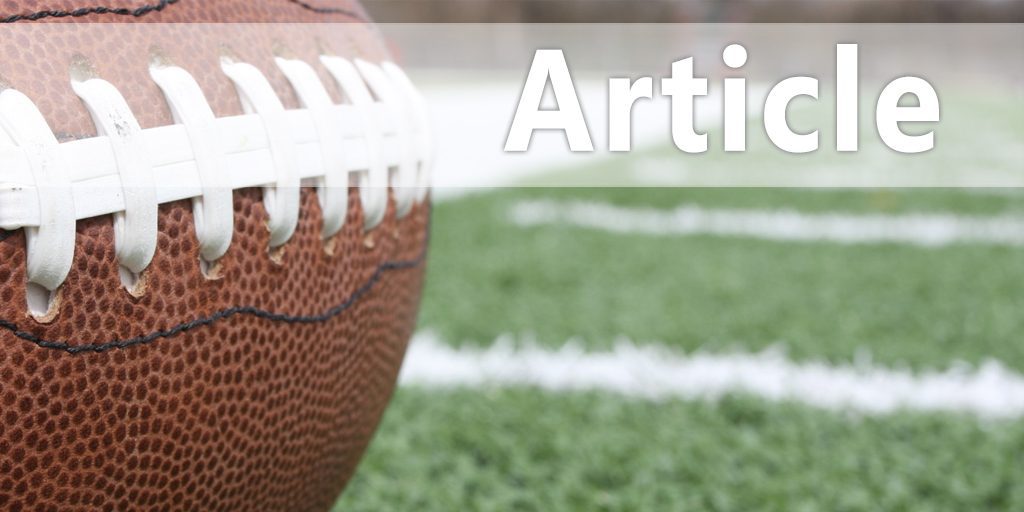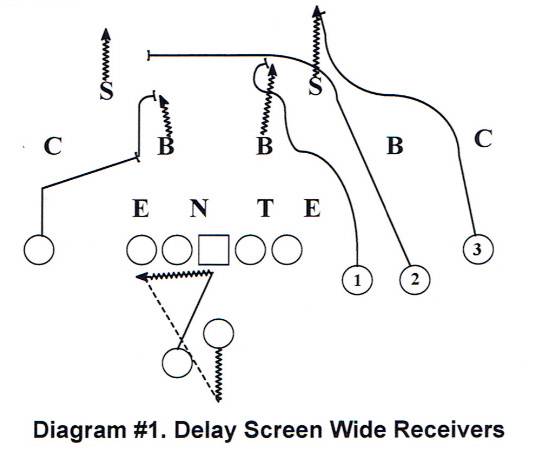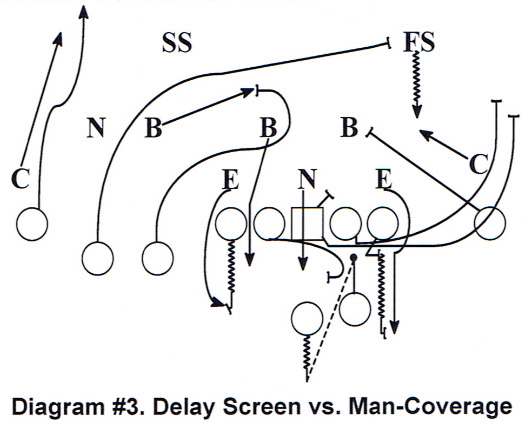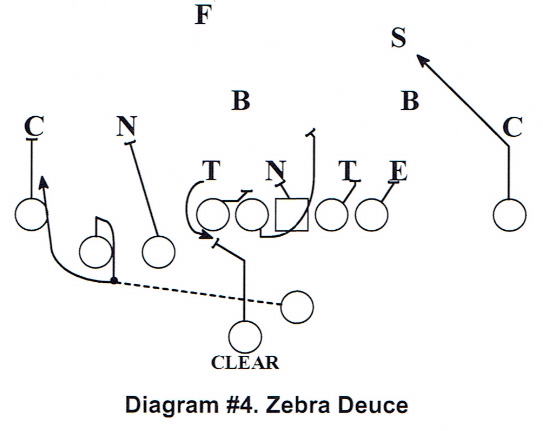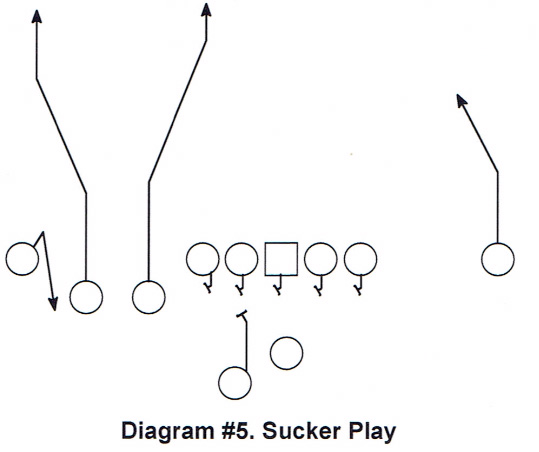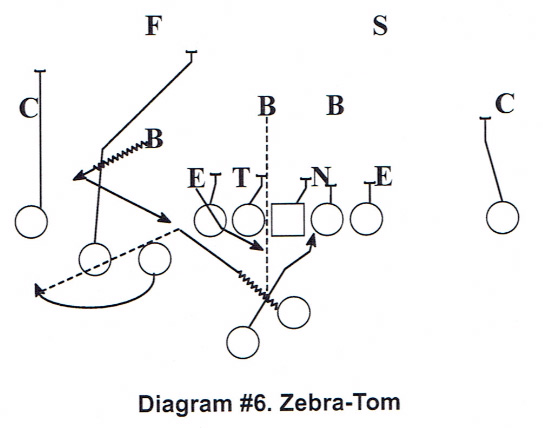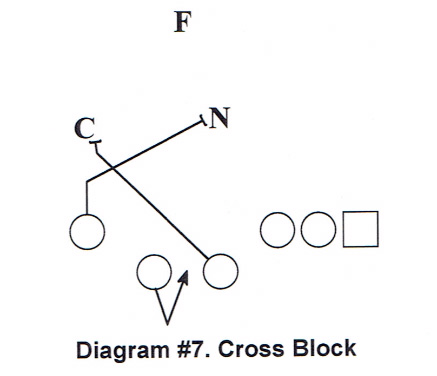| Detachment Screens |
| By: Tom Karlo - Grossmont High School (CA)
Originally Published in: Nike 2016 Coach of the Year Clinic Notes - By Earl Browning Provided by: Nike Coach of the Year We call our screens "Detachment Screens". We do not want our offensive linemen downfield. I know at Arizona, they teach their offensive linemen to contact the defender and drive him back, however, if they feel he is doing something else besides rushing the passer they can retreat to the line of scrimmage and not get the ineligible downfield call. We are going to throw our screens behind the line of scrimmage and avoid those calls. We throw detachment screens, which are screens that are totally detached from the box. If you asked our offensive linemen what types of screens we use, they have no idea. In the RPO's they do not know a screen is being run. They are blocking a run play. When we signal in a play, we signal the offensive line something entirely different. We run these screens as RPO's and as a part of the normal package. I am going to start with the delayed screens. Other people love this screen. Delay Screen • Coordinated play with everyone having specific rules • Sidewalk, Alley, and Rat blocking concept • O-Line must be in sync when they leave • Wide receivers are 100-percent involved • We like it against ° Blitzing defenses or one-gap defenses ° Fast or up the field defensive ends Teams with deep dropping linebackers • Not good against ° 2-gapping defensive line ° Tired defenses (late in a drive) • Can run as a double screen (backside bubble/ detachment This is a running back screen. The running back delays in the line and pops out. We have a very specific way of running the screen. It is very effective for us and we have specific ways we do it. I do not see people running this screen any more. We did not do this screen this year as well as we did in the past. That probably has something to do with the personnel we had. The offensive line has a sidewalk, alley and a rat blocking scheme. I will get to that in a minute. Part of the success of the play depends on the offensive line getting out in sync. The wide receivers are our touchdown makers on this play. The more the defense penetrates the better the screen. We are a zone read team and defensive ends like to get up the field and stop the quarterback run. We like to run the play in third and 20 because the linebacker is running out and getting deep. We like to run the play when the defense is fresh and not tired. Therefore, we run it early in downs and not late in drives. We can run this screen as part of a double screen. We can run the bubble screen to one side and the delay screen to the other. The quarterback can make his count and decide where to go with the ball. Running Back Delay Screen: • Quarterback: Three-step drop, stop and sink, stare downfield and draw defenders, find a throwing lane • Running Back: Get lost in the line of scrimmage behind the offensive guard. When he leaves the back snaps his head around for the ball, he should catch the ball in the offensive tackles area • PSWR: Block the first linebacker to your side if off coverage. 2-steps up and go for linebacker. If pressed go immediately • 1st Backside Wide Receiver: Reverse block the first linebacker to your side, use your body • 2nd Backside Wide Receiver: Go block playside two high safety or one high safety, slow to go, TD block • 3rd backside wide receiver: Go block your side safety or the man over you, go slow, TD block The quarterback takes a 3-step drop and sets up. (Diagram #1) He stares down the field the entire time. He stops and begins to sink (backpedal). He wants to draw the rushing linemen. The running back comes forward and gets lost in the line of scrimmage. He is in the vicinity of the playside offensive guard. The guard leaving is his trigger to snap his head around to receive the ball. He wants to catch the ball in the area of the playside offensive tackle.
We generally run this play from a 3 X 1 formations. We run the play to the weakside of the formation. The playside wide receiver blocks the first linebacker to his inside. He does not want to go immediately to the linebacker. If he does that he brings the corner right to the screen back. He drives up the field for two steps and breaks inside to block the linebacker, who will be retreating to his zone coverage. That gives the corner the illusion that the receiver is running a vertical pattern. The first-wide receiver to the trips side is our number-3 receiver. His assignment is to block the first inside linebacker to his side. He wants to use a reverse block on him. The linebacker will be in a drop to his zone. The receiver wants to get inside him and block him. He will have to run down the field to get into position to block him. He wants to be on the playside of the linebacker in between him and the running back. The second-wide receiver to the trips side is the number-2 receiver. If the coverage is a two high safety, he blocks the high safety to the side of the play. He cannot run directly to him. The timing of the screen is going to take from 3-4 seconds before the running back has the ball. If he goes in a hurry, he will be at his block too soon. He starts down the field and goes slow to his block. He does not accelerate to his block until the running back starts to move downfield. He wants to make his block as the running back is getting to him. The third-wide receiver, which is the number-1 receiver blocks the high safety to his side. If the coverage is Cover-3, the number-2 receiver blocks the middle of the field safety and the number 3 wide receiver blocks the man over him. He uses the slow go technique. If they block too early, they waste their blocks. They must deliver the block which springs the touchdown. Coaching Points: • Quarterback has to get depth against blitz • Get the ball there any way possible (sidearm, jump, bend, etc.) • Quarterback throw a dart • Running back cannot get hit or knocked off his path (avoid contact) • PSWB do not let corner trigger fast on the screen (hold him) • Backside receivers do not block until they feel the running back breaking it (do not waste your block) • Backside receiver if your man blitzes, keep climbing and find someone to block • No Blocks In the Back • No Blocks Behind the Play If there is a blitzing linebacker, the quarterback will have to sink deeper. When he throws the ball he is not throwing the ball hard. He is throwing it like he would throw a dart in a dart game. The last coaching point is essential. We scream as the play is going on. "No Blocks Behind the Play" and "No Blocks in the Back!" Penalties will kill a big gainer and destroy momentum created by the big play. Delay Screen - Offensive Line Assignments Tackles: Hard inside pass set, inviting defensive ends outside. Attack his inside shoulder pad and hip driving him outside and up field - NO STALEMATES! Playside Guard: Quick pass set, count to 2-seconds. release to kick out the corner back. Stay flat to the line of scrimmage and do not break down at the block; SIDEWALK Center: Quick pass set. count to 2-second. release to block the playside linebacker or nickel back; ALLEY Backside Guard: Quick pass set. count to 2-seconds, turn back toward the quarterback, look to block any retreating defenders trying to chase the back: RAT The offensive tackles must block the defensive ends and stay on them. (Diagram #2) They take an inside pass set, attack the inside shoulder and hip. and drive them outside and upfield. They do not want to hold but they want to drive the tackle completely out of the play so they do not fall back on the running back. They must push the tackle wide and deep. We cannot have any stalemates close to the line of scrimmage.
The best part of the play starts with the playside guard. center, and backside guard. The techniques they use are called "Sidewalk, Alley. and Rat". The first thing that have to do is use a quick pass set. We do not want them to retreat off the line of scrimmage. They take two abbreviated steps back and invite the rush. If they set back two yards. they have to recover that before we can run the screen. The playside guard is the trigger for the running back. He is setting up behind the playside guard to receiver the ball. The two guards and the center must be in sync when they leave the line of scrimmage. That is imperative to the play. If they leave at different time, there is no continuity. The playside guard is what we call the "sidewalk." He quick sets, counts 1-second, 2-seconds, and releases flat down the line of scrimmage. His job is to kick out the corner on the play. He wants to stay flat and see the corner. If the corner has retreated into coverage, he turns up the field and looks for the most dangerous man. The rule for the "sidewalk" is once he gets to the numbers on the field, he turns north and south. The center's block is called the "Alley." He blocks the defender in the alley on the edge of the box. That is the weakside linebacker. The playside receiver is assigned to him, but we want to make sure he does not get involved with the play. That linebacker is assigned to the running back. The linebacker is eyeballing the running back for a release or block. He will be the first defender to see the screen and we must take care of him. We have a double team on him. If the linebacker drops into coverage, the center looks for the next player in the alley. The backside guard has what we call the "rat" block. He has a quick pass set and holds for 2-seconds. He opens to the center and blocks any retreating linemen rushing the quarterback. Defensive line coaches coach their linemen to retrace their steps on a screen or draw play. That is who he is looking to block. We very seldom have that block to make. If there are no retreating defenders, the guard turns up field and gets into the blocking scheme downfield. Coaching Points • We want all defenders up the field (go get the quarterback) • Do not get depth on the quick set (stay on LOS) • Do not hit linebacker blitzing from depth • Do not engage defensive linemen • Throw you knife • Keep your shoulders square to your work • Center and PS Guard, do not push defender to the play side • Alley - double team on playside LB is okay • Playside Tackle, do not let your defender escape downfield (pin him and protect where the ball is going) We do not want the defenders staying at the line of scrimmage, we want them up the field. Do not impede their progress at the quarterback. If a linebacker blitzes from depth. do not engage him. If we hit the linebacker and stop his momentum, he will be in the middle of the screen. Let him go so he gets out of the way. The defensive line will make contact with the offensive linemen. However, the guards and center want to make hand contact and kind of wipe the defender inside and let them go. We do want to punch or stun them. We want to put the hands on them and wipe them to the side so they will get off the line of scrimmage. When we tell the linemen to "throw their knife" that is in reference to their blocking. We do not want the linemen to break down on the defender. We want them to run through their block. The defender is going to take on the block or try to avoid it. If he tries to avoid, the back can break the other way. We want to run over the defender. If he tries to avoid, he is going sideways, which is what we want. The playside tackle must keep his defender from recovering to the outside. He wants to pin him upfield and make him release to the inside and not the outside. On the screen, everyone has a specific job to do. If they all do a good job, we have a successful play. If we run the delayed screen against man-coverage in the secondary, we have a few technique changes. (Diagram #3) The playside wide receiver in a press coverage situation does not push up the field for two steps. He goes immediately for the first inside linebacker. When he goes inside, the corner will go with him because he is in man-coverage.
The block does not need to be a killer block. We want to shield the linebacker so he has to come under the block, which puts him behind the play. This is an important block because that is the linebacker responsible for the running back. If we miss that block, we have no play. The receiver wants to make sure the linebacker cannot get on the running back immediately. He wants to make contact and shield him off the play. The playside guard releases flat to kick out the corner. However, the corner went inside with the path of the wide receiver and is out of the play. The center releases and has an option of wrapping for the inside linebacker or leading if there is no threat. The rat blocker cuts off any retreating defenders from the pass rush. The rat blocker is the one of all the linemen who could get a block in the back call. We tell him if there is any doubt whether he gets in front of the defender, do not block. He is generally behind the play and should not block back. The number-1 receiver to the backside can come across or simply run off the defender covering him man-to-man. The thing we emphasize with our guards and center is to keep their shoulders square as they get into their responsibilities. If their shoulders are turned parallel to the sidelines, they can only go one way. We want their shoulders parallel to the line so they have freedom to turn either way. Detachment Screens • Can run it as an RPO or called play • RPO - screen is tagged onto a running play or built in • Called play - separate action for quarterback and running back • Designed to go outside (make defense run laterally) • Like them late in series or in game • Boundary or field side play • Outside, middle, or inside receiver can run it in a 3 X 1 formation • Backside receiver runs his single receiver route rules (quarterback looks for that in certain situations (matchups) • Mirror screens in 2 X 2 formations The detachment screen can be called as an RPO (run/pass option) or as a called play. If we are going to run the screen as part of an RPO we tag it to a running play. If your inside zone play is called "zebra" and the detachment screen is called "Roger", the RPO call is "Zebra-Roger." The offensive line only hears "zebra" because that is the running play and that is what they block. When we call the screen as a called play, the offensive line coach signals a separate action for the offensive line. He can dress the play up a bunch of different ways. We call the screen left. The offensive line coach can signal power right, counter left, power left, or any number of plays. If the quarterback knows we are going to throw the ball he does not worry about a running fake. He comes out throwing the ball from the get-go. The line runs whatever the offensive line coach called. The backside receiver always has a rule; he works with the quarterback. The quarterback can go to him on any play if the situation is right. It is a single receiver route read. The quarterback has the green light to throw that in a certain situation. If we are in a 3 X 1 formation. the outside receiver is the screen receiver. In a 2 X 2 formation we run double screens to each side. The outside receiver is the screen receiver and the quarterback decides which side to throw. Screen Receiver Coaching Points • Steps - -Big, baby. baby" show the quarterback your numbers • Should catch the ball one yard behind the line of scrimmage • If pressed. take the corner outside and down the field for one step and come back to the quarterback • Catch the ball first!!! • Once the catch is secure, knife for YAC (yards after catch) • 1 cut, 1 cut, 1 cut, 1 cut • Set up your blocks, (two steps inside then bend back outside) • Do not get tackled out of bounds (step out and save time) In the steps the wide receiver catching the ball wants to take one giant step down the field to force the defensive back to retreat. He plants and takes two shuffling baby steps back behind the line of scrimmage. As he shuffles with the baby steps his shoulders are turning into the quarterback showing him his numbers. His shoulders are perpendicular to the line of scrimmage. If the coverage is a press coverage, the receiver drives outside and downfield for one step, plants, and takes two baby steps back to the quarterback with his number exposed to the quarterback. The quarterback throws to the numbers. Every year we have drops because the receiver wants to run before he catches the ball. We must catch the ball and secure it before we can run with it. When we teach the play. we drill the knife after the catch. We do not want to round off the catch as we turn up field. We want to get directly up the field at sharp angles after the catch. So many times when the receiver catches the ball. he turns inside behind the blocker and continues to run inside up the field. That is where all the defenders are. We want to catch the ball turn up field for two steps and bend back to the outside away from the pursuit. If we are in a clock situation, we want the receiver to step out of bounds. If he is hemmed in to the sidelines there it makes no sense to try and get one or two more yards. Step out of bounds and save the time. If he is pushed out of bounds. he will go five yards out of bounds or into the bench area, which takes extra time to get back to the line of scrimmage. Blocking Coaching Points • Block next man over concept (run off if pressed man coverage) • MDM if defense is moving late (most dangerous man) • If zone coverage, take two steps up, then assignment • If wide receiver is pressed go right now and kick out the corner back • Hit defender square with staggered feet, then slide to outside shoulder and pin inside • Ball is designed to go outside • If tagged on a run play slow down your block on zone coverage If the middle man catches the screen the blocker is the next man over. If the first receiver gets the screen, the blocker is the next man over. If the coverage is zone coverage every one of the wide receivers are taking two steps up the field, even the screen receiver. That gives the illusion of a pass play. If the blocker goes right away in zone coverage, he brings the defender immediately to the ball. The difference is in man-coverage. we do not release up field. and we go immediately to the block. The blocker cannot go at the outside of the defender. If he does the defender will undercut the block and get inside. When the blocker comes at the defender he has to be square with staggered feet. Once he makes contact. he slides to the outside shoulder and pins him to the inside. If the screen is tagged onto a running play, the blocker and receiver want to slow down. There is going to be a run blocking scheme going on to the inside. You want to give it a chance to affect the defenders. We do not want to block too soon and waste the block. If the blocker blocks the defender and the ball is still inside, he cannot hold his block that long. Block when the ball is on the way to the receiver. Quarterback Coaching Points • RPO - pre-snap reads ° Based on numbers, the situation, can he get yards? ° Give "clear" call to running back and get ball out as quick as you can • RPO - post-snap reads (feel) • Go through the normal read progression • Big eyes to see if the coverage is rolling late ° Pull and throw against late blitzing perimeter defenders (bonus guys) • Catchable ball • Aim for the top tip of the receivers upfield number (aim small, miss small) • When in doubt give it to the running back The quarterback has to count the numbers in the box. If we are outnumbered, he wants to throw the screen. However, the situation will dictate what he may do. If he wants to keep the clock running an incomplete pass will stop it. If it is short yardage, he may want to keep possession and not risk the throw. The third thing is whether the throw is worth the yardage he can hope to get. If the quarterback cannot see the play in his pre-snap read, he wants to put the ball in and ride the running back. That gives him a chance to read what the defender is doing. However, he needs to have big eyes to see anything that can affect the play immediately. If the corner rolls at the last second, he needs to see that. The quarterback cannot be wrong on his decision. If he is in doubt what the defense is doing, he gives the ball to the running back. When he throws he wants to aim at a small target. We say aim at the top of the inside number of the receiver. If he misses his target it is a small miss. We do not want him to aim for the upfield shoulder and miss badly. That leads to a pick six. That is what we talk to the quarterback about on the RPO's. Some are good at it and some struggle. On this play, the formation is a 3 X 1 formation. (Diagram #4) The trips Basics of the Multiple 3-4 Defense set into the boundary. On the play, we call a power run into the field and a screen into the boundary. I called "Deuce", which means the screen is going to the number-2 receiver in the trips set. We give one signal with two different plays and it takes 8 seconds to get it into the game. The call is "Zebra-Deuce", which is the power play to the right and the screen to the left.
If the quarterback in his pre-snap read knows he is going to throw the ball, he can give a "clear" call to the running back. That releases the running back from the run fake and he is a personal protector to the trips side of the formation. The line is still blocking the power right. Anytime you run the screen and the defense knows you like to run it, they will over load the trips set. (Diagram #5) You must have a sucker play from that set. When we call the play the line is blocking our five-man pass protection scheme and not running a play.
The single receiver has a called play depending on what we want to run. The outside receiver in the trips set fakes the screen. The inside receivers are faking their inside blocks and going deep up the seam and into a fade down the field. You must run it to keep the safety from reacting down to the screen quickly. If he does, we must have an answer for it. We have another option type play the quarterback can run. (Diagram #6) We tie this play to the inside zone. The quarterback reads the backside end on whether to give or pull the ball from the running back. If the defense brings the outside linebacker to take the quarterback as he pulls the ball. the quarterback attacks the outside linebacker. When the outside linebacker attacks the quarterback he throws to what we call -Tom-, which is a bubble screen route by the number-3 receiver to that side.
The linebacker has to play the quarterback or the bubble route runner. If he covers the bubble the quarterback runs the ball. If he attacks the quarterback. we throw the ball to the number-3 receiver. We block the inside zone right and run the Tom play to the left. In our blocking assignment to the screen side we can use a cross blocking scheme. (Diagram #7) Instead of blocking the next man rule. we block a cross block. The outside receiver blocks in and the number-3 receiver block the out.
The single receiver in the trips set has a route rule. If he is pressed, he has a go route. If there is access to the field. he runs the slant. We can call any special route for him that we choose. To the three receiver side we name the receiver as to who is going to catch the screen. What we did today in this clinic was name the outside receiver Oscar, the number-2 receiver Steve. and the number-3 receiver Tom. We do the same thing but with different calls. It is simple and fast. This is difficult to defend because it leaves many one—on-one matchups across the board. When you do this with the tempo game. it becomes a nightmare for the defense. We want to run as many plays in a game as humanly possible. I appreciate your time. Best of luck to you. |
